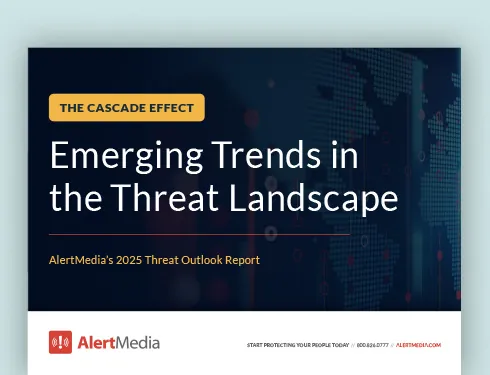
Understanding the Global Risk Landscape: Insights for 2025 and Beyond
Navigating the many threats of today’s global risk landscape requires a thorough understanding of the threats you may face, so you can better plan for how to stay resilient through disruptions.

In an increasingly unpredictable world, businesses must learn to thrive amidst chaos. This ability is most effective when organizations adopt an “anti-fragile” mindset. Coined by philosopher Nassim Nicholas Taleb, “anti-fragility” describes systems that grow stronger from resilience—and volatility, disorder, and uncertainty. For businesses, this mentality shifts the focus from simply surviving risks to actively seeking opportunities within them.
Through 2025 and beyond, organizations of all sizes will face challenges that are only increasing in scope and severity, from geopolitical tensions and climate change to technological disruptions and socio-economic inequalities. Those that adopt an anti-fragile approach to risk are better positioned to adapt, innovate, and use these uncertainties to fuel growth and resilience. Embracing this bold mindset is not just a competitive advantage—it’s essential for survival in a world where the unexpected is the new norm.
This article will explore the critical threats and trends in today’s evolving global risk landscape that businesses may encounter in the coming years. It will also include strategies for developing an anti-fragile mindset so your organization can weather potential storms and emerge stronger on the other side.
Download Our 2025 Threat Outlook Report
What Is the Risk Landscape?
The risk landscape refers to the ever-evolving set of internal and external threats and uncertainties that can impact an organization’s ability to achieve its objectives. A view of the threat landscape can be localized to one business location or broadly applied to threats worldwide—known as the global risk landscape.
These threats may stem from operational risks, strategic risks, technological risks, regulatory risks, environmental risks, geopolitical risks, and reputational risks, among others. The global risk landscape is shaped by market changes, emerging technologies, societal shifts, climate change, and more.
Critical Risks in 2025
The risk landscape of 2025 is likely to see many of the same threats to business operations and employee safety as in previous years. For example, severe weather, cyber attacks, supply chain disruptions, and other familiar risks will likely feature heavily. However, incidents throughout 2024, such as wars in the Middle East and Europe, economic uncertainty, and accelerating climate change, have created unique threat situations that necessitate preparation from businesses in any industry. Here are a few ways these main threat factors are creating critical risks for global companies in the coming year and beyond.
—Sara Pratley, SVP of Global Intelligence at AlertMedia
Geopolitical tensions
Geopolitical tensions are escalating around the world, driven by factors such as societal polarization, the emergence of populist leadership, and shifting political landscapes. The Ukraine-Russia war, for example, has led to a humanitarian and refugee crisis and has significantly disrupted energy supplies across Europe, raising concerns about energy security and inflation. Similar repercussions have stemmed from the conflict between Israel and Hamas in the Middle East. Such disruptions directly affect a wide variety of industries, but especially those that rely heavily on energy inputs, leading to increased operational costs and potential delays in production.
Moreover, the rise of nationalistic and protectionist policies, such as the recent trade wars between the United States and China, presents potential challenges for global economic collaboration. These trade disputes have resulted in tariffs on a multitude of goods, affecting various sectors from agriculture to technology. Companies must navigate these changing regulations and tariffs, which can have far-reaching implications for pricing strategies, profitability, and market access.
Business leaders must closely monitor these geopolitical developments, as they can lead to severe supply chain disruptions. For example, companies heavily reliant on manufacturing in politically unstable regions may experience delays or increased costs due to civil unrest, sanctions, or governmental interventions. Supply chains can be fragile, with far-reaching and long-lasting disruptions from single incidents. Organizations need to develop robust contingency plans to manage these risks effectively.
Economic strains
Economic risks such as inflation rates have surged globally over the last several years, spurred by supply chain disruptions, high consumer demand, and rising energy prices. While interest rate hikes have helped slow inflation, recovery has been slow, and prices in many sectors have remained high. For businesses, this means increased operational costs, especially in wages and raw materials. Failure to adapt to inflation through the coming years could erode profit margins, as passing costs to consumers might not be viable in price-sensitive markets and a cost-of-living crisis.
The inauguration of a new U.S. president potentially complicates global economies further. Trade tensions, tariffs, and import restrictions would impact various sectors like agriculture and technology. Companies relying on international trade must navigate these fluctuations, as changes in trade policies affect pricing, competitiveness, and market access. Increasing costs for importers and reduced demand for exporters exemplify the challenges they face.
Labor challenges will also add to the economic risks throughout 2025. Strikes and labor activism have seen a strong surge over the last few years in industries such as manufacturing, healthcare, dock work, and more. These strikes add to supply chain risks and can even pose a threat to transportation, such as with the Canadian rail strike. Additionally, some businesses are finding it hard to recruit and retain talent. Healthcare facilities, in particular, have faced labor shortages and turnover. Economic concerns can threaten the very foundation of businesses in all industries, and organizations need a thorough and adaptable plan for how to navigate these risks as they develop.
Climate change challenges
Ongoing climate change is exacerbating extreme weather patterns, such as hurricanes and floods, and is reshaping business operations across the globe. Coastal cities are grappling with rising sea levels, while agricultural regions experience increasingly unpredictable weather conditions such as floods and drought. Aging infrastructure faces significant vulnerabilities; the costs of repairs following climate-related disasters can be staggering for both municipalities and private enterprises. To combat these issues, leaders are urged to promote resilient designs that incorporate climate adaptation strategies from the outset of planning processes.
Moreover, climate-related incidents wreak havoc on supply chains, resulting in production halts and shortages. Businesses are compelled to adopt resilient supply chain models, which involve diversifying suppliers and establishing increased inventory buffers to ensure continued operation in the face of disruptions.
The rising costs associated with disaster recovery place additional strain on government resources. Economic losses stemming from natural disasters can tally in the billions annually, stressing the need for proactive planning. Companies must therefore integrate environmental risk assessments into their long-term strategies, invest in proactive risk mitigation, and revise emergency response plans to cope with climate-related challenges effectively.
Emerging Trends Influencing Risk Management
The global risk environment is constantly in flux. Technological advances, policy changes, major disasters, and geopolitical shifts all have significant impacts on the trajectories of evolving risks in the short term, and the longer-term risk forecast. Staying ahead of these emerging trends better prepares organizations to mitigate the top risks of the next decade. Here’s what you can expect to carry significant influence.
Increasing governance of artificial intelligence
Artificial intelligence (AI) offers powerful benefits but also introduces significant risks, especially when ethical considerations are neglected. Without robust governance, AI can introduce biases, privacy risks, and operational vulnerabilities. Risk managers must integrate ethical governance frameworks that mitigate these technological risks by establishing protocols for AI transparency, accountability, and security. Regular assessments and transparent, ethical implementation of AI systems are critical for reducing potential liabilities and enhancing the organization’s trustworthiness.
Proliferation of misinformation and disinformation
The rapid spread of misinformation and disinformation presents a growing threat to organizations, particularly as GenAI makes the creation and spread of false information easier and faster. False or manipulated content can quickly erode trust, damage reputations, and create confusion among stakeholders, including customers, employees, and investors. To mitigate this risk, organizations must prioritize media literacy, invest in tools to monitor and counter false narratives, and establish transparent communication strategies to address misinformation proactively.
Widespread supply chain disruptions
In an increasingly interconnected world, disruptions in the supply chain—whether due to geopolitical tensions, natural disasters, or other external factors—pose a considerable risk to organizational stability. Companies must implement resilient supply chain strategies, such as supplier diversification, local sourcing, and technology investments to increase visibility and agility. Building this resilience is essential for organizations to proactively anticipate risks and adapt quickly to unpredictable shifts in the global marketplace.
Deteriorating seasonal weather boundaries
The impact of climate change is altering traditional weather patterns, making extreme weather events more frequent and less predictable. This shift in seasonal weather boundaries, including prolonged droughts, unexpected flooding, and extreme temperatures, poses direct and indirect risks to businesses, especially those reliant on predictable seasonal cycles. Organizations must now consider these spreading environmental catastrophes in their risk assessments and strategic planning. For effective risk management processes, adaptive infrastructure planning, enhanced emergency response strategies, and climate-resilient supply chains are crucial.
“During Hurricane Helene, there were conversations about climate havens, or areas where people thought they were safe from certain natural disasters. These havens are no longer really exempt. Climate change has shifted the seasons and locations of severe weather so nowhere is truly safe.”
—Sara Pratley, SVP of Global Intelligence at AlertMedia
Hostile use of drone technology
The rise of drone technology presents both unique opportunities and risks for businesses. While drones can enhance operations in sectors such as logistics, security, and agriculture, they also introduce new risk factors. Drones are increasingly used as tools for hostile intent, with a recreational drone-flown bombing incident in Maine, and a thwarted bombing of an energy facility in Tennessee. Organizations need to assess the potential risks of drones to their facilities, establishing clear guidelines for their mitigation to prevent accidental breaches, data privacy violations, and potential security threats.
Actionable Strategies for Navigating Risks
Today’s risk landscape demands more of safety, security, and business continuity professionals. Standard practices of assessment and risk management strategies struggle to keep up with the rate and severity of the threats to organizations. Here are a few ways that your business can adapt and advance your risk management to set up for success in navigating the modern risk landscape.
Invest in mitigation techniques for anticipated risks
Proactively investing in mitigation techniques is essential for organizations to address both immediate threats and emerging challenges effectively. One of the most impactful strategies involves diversifying supply chain networks, which can significantly reduce vulnerabilities related to potential disruptions. By establishing strong partnerships and enhancing communication channels, organizations can further mitigate the impact of unforeseen events.
Additionally, cultivating a culture of awareness and preparedness plays a vital role in risk management. This includes investing in training programs that equip employees with essential skills in risk recognition and crisis management, thereby enhancing their ability to respond effectively to potential threats. Not only does this investment fortify business resilience, but it also strengthens the overall security posture of the organization, allowing it to navigate the complexities of the global risk landscape with confidence.
Use technology to improve efficiency
The right technology can act as a vital catalyst for enhancing efficiency in risk management. Advanced data analytics enables organizations to gain insights into potential vulnerabilities, streamlining decision-making and resource allocation. Furthermore, technologies like artificial intelligence (AI) and machine learning allow for more accurate risk forecasting by analyzing patterns and predicting future risks. This proactive approach helps businesses prepare for contingencies, minimizing disruptions and ensuring operational continuity.
Integrating technology-driven solutions also fortifies cybersecurity measures, essential as digital threats continue to grow. Investing in cutting-edge cybersecurity systems, such as intrusion detection systems (IDS), cloud security solutions, and endpoint protection platforms, is crucial for safeguarding sensitive information. By adopting a technology-focused approach, organizations can enhance their operational efficiency and resilience, enabling them to navigate the complexities of the global risk landscape confidently.
—Sara Pratley, SVP of Global intelligence at AlertMedia
Broaden the scope of risk assessment practices
To navigate today’s rapidly evolving global risk landscape, organizations must enhance their risk assessment practices to include a broad spectrum of potential threats that could disrupt operations and undermine resilience. Security leaders and business continuity professionals should adopt a comprehensive method that identifies both traditional and emerging risks, such as geopolitical tensions, social dynamics, and technological advancements. This requires a cross-functional collaboration involving stakeholders from various departments to uncover vulnerabilities linked to organizational practices. Additionally, applying real-time data and advanced analytics will empower businesses to proactively monitor trends and adapt their strategies, ultimately strengthening resilience while allowing them to seize opportunities in an increasingly complex environment.
Moving Forward in a Volatile World
Understanding the global risk landscape is essential for leaders focused on security, business continuity, and resilience. With rising security risks, economic uncertainties, and environmental challenges, effective risk management strategies are critical for addressing future threats like technological risks, political shifts, and societal polarization. Embracing comprehensive enterprise risk management can help mitigate disruptions from supply chain issues, armed conflicts, and extreme weather events, necessitating prompt assessment and adaptation to potential threats.
Organizations should adopt a proactive approach by integrating risk priorities into strategic planning, continuously updating threat assessments, and fostering collaboration through information sharing. By staying informed and adaptable, leaders can create a more secure and prepared future amidst the complexities of a changing world.

![4 Steps to Conduct a Business Threat Assessment [+ Template]](https://www.alertmedia.com/wp-content/uploads/2022/07/Blog-Image-Business-Threat-Assessment-V1.jpg)


